Implicit Cosmology
Abstract
The Trans-survival Hypothesis is concerned with the relationship of personalities to physical bodies, transition, the nature of the greater reality and the mechanisms of trans-etheric influence.
A person is seen as a physical body and an etheric personality entangled in a symbiotic relationship with the physical body functioning as an avatar for personality. Personality normally has a life field-centric perspective. The avatar relationship is modeled as a means by which personality may experience the physical aspect of reality from a physical body-centric perspective. It is speculated that the purpose of this is to enable the personality to have experiences in the physical venue with the expectation of gaining understanding about the operation of reality given the constraints of physical principles.
The personality is seen as having evolved separately from the physical body, and when the physical body is no longer able to sustain life, the personality is free to return its focus of attention to the etheric in a process referred to as transition; colloquially as death and dying.
The personality-body avatar relationship is seen as involving a form of entanglement which is thought to be required for trans-etheric influences. Based on this, transcommunication is seen as dependent on the avatar relationship, making it necessary for discarnate personalities to cooperate with persons to communicate or influence physical processes.
Editor’s note: As you read this hypothesis, please keep in mind that it is a theoretical model designed to describe observed phenomena and results of considerable study by many researchers. Even though metaphysics has been around for centuries, this current view is based at least in part on research enabled by the introduction of instrumental forms of transcommunication (communication across the veil).
A hypothesis is designed to be tested and refined, so what you read here should not in any way be considered fact, incontestably true or official ATransC policy. With that said, it would not be on this website if it was not thought to be substantially correct. It is being used as the working hypothesis for understanding things paranormal.
Your comments and suggestions are invited to help vet this model.
Please submit your comments using the Contact Tool at the bottom of each page.
Introduction
A common complaint from people “observing” the paranormal community is that there is no theory to explain the existence of the phenomena. So the question is, “How do you think what you are experiencing makes sense as real and not imagined experiences?” The Survival Hypothesis, as the term is used in parapsychology, is little more than a place holder, and few people working in Etheric Studies have obtained the level of understanding to warrant speculation on how what they know to be true might be possible.
I am no further along than many of my peers, but as a director of an international organization that has been studying these phenomena, it seems a form of dereliction of duty not to at least propose a model. In my experience, having something to change is a lot easier than beginning with a blank page. As such, this is my offering for something to change. I invite you to help evolve it into something more people in our community can accept as a working hypothesis.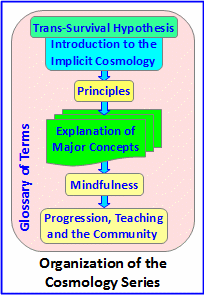
Organization of Supporting Material
This document includes a top view of the hypothesis. The implications of this hypothesis are briefly addressed here, but they are explained in detail in the Implicit Cosmology. There are also many articles intended to clarify specific concepts identified in the Implicit Cosmology. Access to these is by way of an index provided on the cosmology page and at the right of each page of the Concepts section (this section).
About Hypotheses
As it is generally referred to in parapsychology, the Survival Hypothesis is simply the conjecture that some aspect of a person survives physical death. While there is substantial literature on survival from Spiritualism and naturalist-styled reports about various forms of spirit communication, there is very little on the subject of survival based on objective study. The Trans-survival Hypothesis is so named to maintain at least some identity with the better-known Survival Hypothesis, but it is actually a hypothesis designed to describe our immortal etheric personality, the greater reality in which our personality exists and the relationship between the greater reality and the physical aspect of that reality.
The objective of a hypothesis is to provide a context in which relevant phenomena, both mundane and anomalous, can be considered as a system for critical evaluation. Hypotheses should include itemization of what is considered to be given as initial considerations. As a unifying model of reality, initial considerations would include observed phenomena, circumstances under which they are experienced, and the scope or limits to which the hypotheses apply.
Next, hypotheses should propose a way in which the givens combine to interact as a system. This includes physical properties such as technology and human interaction. Known or proposed properties should be substantiated with some measure of rational, and if available, empirical or objective research.
It is important that hypotheses provide predictive implications of the proposed theory. Ideally, these would be testable. Any hypotheses should be able to be proven wrong; however, in a practical sense, verification might be partial or delayed awaiting new technology or funding for research. As such, hypotheses might remain open for discussion for many years.
Perspective
Most hypotheses are designed from the perspective of a physical person surrounded by the universe. In the first two hypotheses discussed below, the physical perspective constitutes all of reality. The reader needs to be aware that the Trans-survival Hypothesis is designed from the perspective of a person standing at the hypothesized physical-etheric interface so that both etheric and physical characteristics are considered as a system. The reader should be mindful that the perspective of a physical person and an etheric person might be discussed in the same paragraph.
Black Box Analysis
Listed here, are the three dominant views of reality along with their primary features: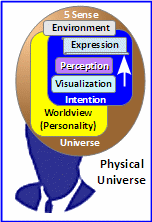
- The Physical Universe Hypothesis
- All that exists is the physical universe.
- The universe has evolved from a singularity into what it is today.
- Life has evolved on earth from a primordial soup into what it is today.
- Mind has evolved as a product of brain which is a product of evolution.
- Memory is an artifact of mind.
- When the brain dies, mind and memory cease to exist.
- People have five senses: smell, sight, hearing touch and taste.
- The Super-Psi Hypothesis (I now refer to this as the Psi Field Hypothesis)
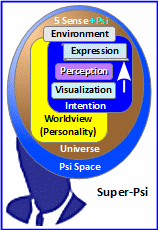
- All that exists is the physical universe.
- The universe may have evolved from a singularity into what it is today.
- An as yet unidentified form of space called psi (psi field) permeates all of physical reality.
- Life has evolved on earth from a primordial soup into what it is today.
- Mind exists in the psi field and continues beyond death of the brain as differentiated, residual energy.
- Brain is a transmitter/receiver for mind.
- Thought, memory and emotions are retained in the psi field.
- People have five senses that are informed by impressions from the psi field.
- The Survival Hypothesis
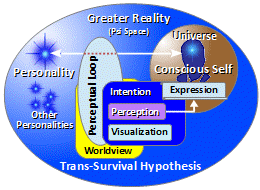
- There is a greater reality of which the physical universe is an aspect.
- An as yet unidentified form of space called psi (etheric, life field) permeates all of reality.
- The psi field is an aspect of the greater reality.
- Mind, with its thoughts, memories and emotions, has evolved in the greater reality and continues to exist beyond death of the brain.
- For a lifetime, mind and brain are entangled to produce a physical-etheric link; a person.
- During a lifetime, mind is expressed as consciousness (I think I am this) and an etheric personality (unconscious, I am this, intelligent core).
- Unconscious mind is informed by the person’s five physical senses and psi signatures from the environment.
Scope of the Three Hypotheses
Of course, the Physical Universe Hypothesis represents the mainstream view. It does not address any of the observed anomalous phenomena and is only listed here for comparison. The Super-Psi Hypothesis is largely supported by the parapsychological community, and the Survival Hypothesis is primarily championed by the community studying transcommunication. The Super-Psi and Survival Hypotheses will be considered here.
The Super-Psi and Trans-survival Hypotheses are described here as sharing the characteristic of psi functioning, but they are shown to differ in how this is accomplished. The contention of the Trans-survival Hypothesis that anomalously accessed information is from a still living personality is a contradiction of the Super-Psi Hypothesis which holds that such information is from a subtle energy field containing memories of the past. The Trans-survival Hypothesis will be described using many of the super-psi assumptions and proofs since the validity of trans-survival depends to a large extent on the validity of many aspects of super-psi.
Important Terms
An effort has been made to use terms in the usual sense; however, there are a few exceptions:
Avatar: An avatar is the embodiment of a personality in a physical form. In the analysis of the relationship between personality and physical body provided in the Comparing Personality-Body Models, the Avatar model best accounts for known characteristics. In that, the personality remains associated (entangled) with the etheric aspect of reality, but its point of view is associated with the physical body and experiences the physical as if it is its physical body.
Cosmology: A cosmology describes the relationship of the various parts of reality–both physical and etheric. The Implicit Cosmology provides a study guide for reading the essays addressing the major subjects. This is not about the physical universe as described in astronomical cosmologies.
Etheric: Etheric is an old term referring to heaven. Following the lead of parapsychology, psi (specifically Psi Field) is used here as the foundation stuff which emanates from a source and from which all of reality is formed. In this model, it is influenced by the intention to produce ideoplastic structures via the creative process, which is the model used here to describe the process life forms use to express themselves. The Psi Field should be thought of as a characteristic of reality from which aspects (sub or local realities) of it are derived by differentiation.
Thought and Expression: In this hypothesis, thought is modeled as a characteristic of life which reacts to external stimuli and internal urges. As modeled in the Functional Areas of a Life Fractal Diagram below, thought has the characteristics of attention, intention, visualization and expression. As expression, thought is involved in the process of differentiation which is discussed in the article, Creative Process.
Imagined Reality: A way of looking at differentiation is to consider how a person imagines a possible experience:
A person might see a sports car and momentarily imagine owning and driving the car. The person would see the car in a familiar circumstance, perhaps driving to work. That sub-reality of the person’s personal reality would be populated with familiar people and a “Little Me” of the person would be driving the car. Such visualization has no value if the person does not allow the imagined scene to play itself out with minimum external influence, so while the person observes the scene, Little Me would have a degree of self-determination and an urge to gain understanding about the experience.
In the end, the person’s Little Me would “return” a degree of understanding about owning the car, allowing the person to learn something it had not known. The imagined sub-reality would cease to exist as the person withdraws attention; however, it would indefinitely continue to exist in the person’s memory and Little Me would remain an aspect of the person’s personality; likely resurrected from time to time for other experiences.
Consider the person’s personal reality a subset of the locale in which it exists, which is itself, a subset of the greater reality represented by Source. The person and Little Me are seen as part of a hierarchy of personalities, and so, the concept holds that reality exists as a hierarchy of personalities extending from Source to Little Me with an unknown number of rounds of differentiation between. The personalities are autonomous with a degree of self-determination but are ultimately part of a collective of personalities. Once the first aspect was imagined by Source, Source becomes a collective of personalities.
Association amongst personalities is modeled as entanglement which becomes established upon differentiation. In this way, conscious self is seen as entangled with its source personality, which in turn is entangled with its source and so on.
Parallel to the hierarchy of personalities are nested aspects of reality in which the greater reality, local reality and personal reality of this scenario can be considered “nested” realities or venues for learning. Some aspects of sub-realities would be shared venues for learning providing shared experiences for some personalities. As such, the physical universe is seen in the physical aspect of reality in which entangled conscious selves (people) share the general nature of the physical via their avatar but have personal points of view (personal reality) codified in their worldview.
Imagined aspects of the greater reality would persist so long as they are held in the attention of at least one personality. Once attention is withdrawn, the sub-reality would persist as a memory in the collective understanding.
Life Field: The concept of life as a fundamental component of reality is an important part of the Implicit Cosmology. Life is treated here as a fractal. Fractals may occur as a top or prime fractal, subsequent to which is a hierarchy of fractals of diminishing scale. As an analog, the Apple Man in the Mandelbrot Set is the top fractal but there are an infinite number of lesser instances of the fractal found at all scales within the number set. In the Implicit Cosmology, Source is considered the prime fractal.
(Image is The Mandelbrot Set from Scholarpedia.com.)
Life is also considered a field as described in the Hypothesis of Formative Causation.3 (See: Formative Field, below) Here, life fractal fields are modeled as functional areas as illustrated in the Functional Areas of a Life Field, below. Of course, each instance of the life fractal will more or less express these functional areas, depending on the evolutional history of the field and current circumstance.
In an avatar relationship, personality and the physical body are different life fractals. However, at least in an entangled association, the two life fractals share the functional areas associated with mind, as illustrated in the Life Field Complex Diagram, above. In that relationship, the link of entanglement is from the personality’s External Expression functional area. Because of the entangled relationship, personality is able to function as the subconscious or “I Am” for the avatar via the Attention Complex; however, the physical body’s instincts and response to the environment represent a substantial influence in the Perceptual Loop, emerging into consciousness of the person as I think I am this.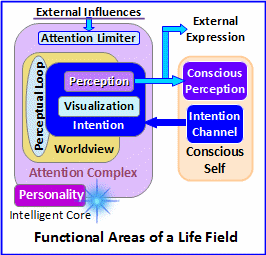
In both figures, worldview is an etheric field containing memory in the form of belief and understanding, and is the bounding effect of memory on visualization and subsequent expression. While the environment induces an impersonal influence on the life fractal, worldview colors that influence according to memory.
Note in the Life Field Complex diagram that the human avatar is shown with a memory functional area that is independent of the etheric personality/conscious self’s worldview. Note also that it is shown associated with a proposed group personality. The conjecture is that animals evolved in the physical have a collective mind which is thought to be partitioned by a worldview which is unique to each instance of the life form. This would be similar to the proposed collective consciousness associated with the etheric personality, which represents the source of the urge to learn inherited by the entangled personality.
Etheric Field: The field concept is an important element in the Implicit Cosmology fields offer a way of describing characteristics of conceptual space without resorting to the idea of energy. In the etheric or conceptual space, attention provides the unit of influence and intention provides the difference in potential.
Etheric fields are regions of reality that can be modeled as a node or nexus (attractor) associated with a set of related elements. These elements might be memory, visualizations, expressions or attention on possible outcomes (intention). A life fractal is a top etheric field (top fractal or organizing field) in an entangled hierarchy of organizing fields.
As considered here, an organizing field can be compared with morphic field; however, organizing field is used here as a more general term to avoid the assumption of organic morphogenesis.
The concept of etheric fields includes formative fields, morphic fields, thoughtforms and ideoplastic structures. The primary difference is in the scope of how this field theory is applied. They may be thought of as psi fields which are a zone of influence in the etheric, for instance, mind as a field or thoughts as expression of mind.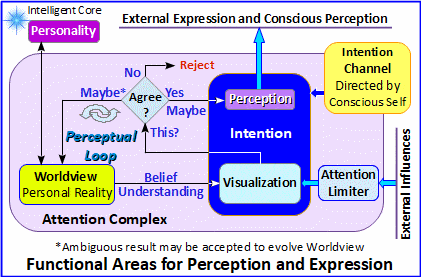
Mind: As has been previously noted, this hypothesis has been composed by an engineer who is not academically trained in psychology, so what you will read here about mind and consciousness may not be found in the psychological literature.
The Implicit Cosmology is a model that has been developed around functional areas of a person as a nonphysical personality entangled with a human being in an avatar relationship. In this context, mind is the collection of functional areas described in the Life Field Complex Diagram.
The term, consciousness is used as a continuum from full conscious awareness to unconscious so that conscious self represents the physical point of view of a personality that is entangled with a human in an avatar relationship.
The mental processes associated with perception are modeled in the Basic Functional Areas of Perception Diagram, above. In that, the rules of perception are thought to agree with the proposed corollaries in First Sight Theory.
Personality: In this hypothesis, the physical body and the personality of the individual are seen as two different components such that the body and body mind are modeled as having evolved on Earth and the personality is seen as having evolved in the greater reality. The body hosts the personality in the physical.
This relationship is described as entanglement in the sense that, while associated with the body, the personality and body function as one. This is modeled as an entangled avatar relationship. The clarity of communication between personality and avatar is referred to as lucidity which is moderated by worldview.
Adapting the First Sight Hypothesis,4 the Worldview, Visualization, Perception and External Expression functional areas are related by a process referred to here as the Perceptual Loop. The rules for the perceptual Loop process are loosely based on First Sight theory.
Trans-: The trans- prefix is used throughout this hypothesis to mean across the etheric-physical interface. In more poetic terms, this refers to any information or influence that crosses the veil between the physical world and the greater reality.
Transition: The physical body dies in the usual sense, but the personality, which is who we really are, continues in a different aspect of the greater reality. This change in circumstance is referred to as transition. Transition is seen as a process that includes the physical death experience, a period of adjustment and introspection (self-judgment) and eventual reentry into a new venue for learning.
There is some evidence that personality is part of a greater community or collective. In this view, personality is expressed as an individual expression of the collective and probably eventually merges with the collective (we are all one).
The physical body has a consciousness associated with the hindbrain, which provides survival instincts. On transition, this consciousness is thought to merge with a collective that is in perceptual agreement with species that have evolved in the physical.
Worldview: This term is central to explanations about the nature of personality. Worldview is considered a functional area of the perceptual process which is much like a database. When a person is born into this lifetime, the worldview database is essentially empty but it has a front-end algorithm which represents personality’s maturity as its prior degree of progression and an inclination toward experiences that offer the opportunity for specific areas of understanding.
The worldview database is populated by culture, family, media, religion and schools as biased by the front-end algorithm. It is the worldview which acts as a filter to determine how the person reacts to situations potentially involving prejudices, beliefs and acceptance or rejection of information. Worldview is thought to follow a person through transition to influence postmortem experiences. More about worldview in the Point of View essay
About Energy
The concept of energy as it is applied in the physical does not appear to apply to nonphysical aspects of reality. Instead, what stands for difference in potential is the influence of intentionality on potential characteristics of ideoplastic structures. That is, form evolves out of visualization which is used as the template for formation. This is essentially the same concept as used in quantum theory in which the quantum “wave function is collapsed by observation,” as it is described by Radin, et al
Commonly used terms, such as spirit and spiritual energy, can be considered synonyms with psi as they are intended. Psi or psi field is used here in lieu of such terms as psi energy (sometimes referred to as psychic energy), auric energy, ectoplasm, orgone energy and od.
Characteristics That Must Be Addressed
Any theory intended to explain reality should address all experienced characteristics. The major categories of these experiences and the community of interest studying them are listed here:
Physical World
The entire suite of physical-world experiences–the mundane–including such experiences as gravity, heat, light, sound, space and evolution.
This category is addressed by mainstream science, at least within bounds of the Physical World Hypothesis.
Psi Phenomena
Information accessed by means other than with the five senses. This includes human abilities referred to as psychic or psi functioning. Examples include remote viewing, healing intention, psychometry, environmental sensing, psychokinesis and mediumship. (Here, mediumship may be transcommunication, but it may also be information accessed from people’s memory of a deceased person and/or the hypothesized residual information representing the person’s past.)
Most theories explaining these experiences do not depend on the existence of survived personality or a greater reality. It is thought to be enough to say that there is an as yet undefined psi field permeating the physical universe that is influenced by intentionality and sensed by a sixth sense.
This category is addressed by the parapsychological community.
Transcommunication
Instrumental TransCommunication (ITC) and the audible subset, Electronic Voice Phenomena (EVP), are the primary experiences in this category. ITC is the umbrella term for both audible and visual forms of ITC, but EVP came first and remains well known as such. After-Death Communication (ADC) is well known as a spontaneous form of transcommunication. Other experiences associated with transcommunication include apports, precipitation, materialization, transfiguration, and yes, mediumship.
Most theories designed to explain transcommunication experiences depend on the existence of the subtle energy field proposed for psi functioning, but also survived personality and a greater (nonphysical) reality. It is important to note that the Trans-survival Hypothesis depends on psi functioning concepts and most if not all known physical principles.
This category is addressed by a few parapsychologists but primarily by citizen scientists.
Residual Psi Influence
A form of “echoes of the past” is postulated to help the Super-Psi Hypothesis make sense. In this concept, everything that is said, done or thought has a psi signature that remains as a form of history in a field permeating the physical universe. Further, it is required that this information can be accessed via psi functioning.
This concept answers what is experienced, however, how this is possible is highly speculative. Conservation of energy is often described as a mechanism for how the energy of memory might be retained. In that physical principle, energy in a closed system is never destroyed, only changed. This principle may not be realistically applied to the psi field since the energy this principle applies to is hypothesized to be a derivative of the influence of intention on psi in the Trans-survival Hypothesis; ideoplastic structures.
Homeopathy offers a possible instance of perpetual memory which might apply to the Super-Psi Hypothesis. Homeopathic dilutions carry the memory of the substance initially dissolved into solution.
Reincarnation, OBE and NDE
These three human experiences provide important insight into the relationship between mind and body. While they clearly show that mind is separate from body, there remains considerable discussion as to whether or not this separation means survival of mind. These three experiences, along with mediumship, are often referred to as the best evidence for survival.1
From the perspective of transcommunication and survival, reincarnation, Out of Body Experience (OBE) and Near-Death Experience (NDE) are seen as providing very important evidence,2 but there has been little support from the parapsychological community in relating that evidence to transcommunication. For this article, these experiences are considered natural consequences of etheric personality-physical body entanglement.
This category is addressed by the parapsychological community.
The Trans-survival Hypothesis
The Trans-survival Hypothesis is a theoretical model developed by Tom Butler for the Association TransCommunication. It is based on the Survival Hypothesis typically referred to in discussions related to mind-body theory. As an elaboration on the simpler model with accommodations for lessons learned from the study of transcommunication, the Trans-survival Hypothesis is proposed as an update.
Statement of the Trans-survival Hypothesis
Top view
Reality exists as a field which is differentiated by the influence of attention on an imagined outcome with the intention that it be so. This intention is expressed by personalities which associate with unique, imagined aspects of reality for the purpose of gaining understanding through experience. A person is a human, which has evolved in the physical, functioning as an avatar for personality. When the human’s lifetime ends, the point of view of personality returns to some other aspect of reality. Trans-etheric influences, which are the expression of personality’s intention, require an avatar relationship.
Initial Conditions
For completeness, the singularity called Source is used as the initial condition for this hypothesis. This hypothesis is concerned with the progression of personality. If just personality is considered, the cause and nature of reality may be ignored.
Initial Condition 1: There is a Source as the top life field and the top organizing field. Source is the reality field.
Initial Condition 2: For simplicity, Source is assumed to be (at least) self-aware and curious about its nature. This curiosity is expressed as attention on an imagined outcome with the intention to make it so. See the Creative Process essay.
Initial Condition 3: Seeking to understand itself, Source has imagined aspects of its personal reality and aspects of itself to experience those sub-realities.
Initial Condition 4: The process of imagining with the intention of understanding has produced a hierarchy of personalities (aspects of Source) and nested sub-realities (aspects of Source’s personal reality.
Initial Condition 5: In response to a Prime Imperative, aspects of Source express aspects of themselves with the intention to understand the nature of reality (which is the nature of Source). This translates as an inherited urge to gain understanding through experience.
Elements of Survival
That which survives is personality as the intelligent core of who we are. The four considerations of survival are the nature of personality, its relationship with its avatar, the process of transition and the nature of reality in which personality survives.
Personality: A personality is a life field, and as such, has a worldview functional area which represents environmental conditioning of the understanding it has gained (progression). This understanding determines the aspects of reality with which it is able to associate. Worldview also represents the inherent instincts expressed by the avatar. Personality is seen as part of a group personality or collective. See the Personality essay.
As an example of a group or collective, a group personality known as the Imperator Group provides the trans-etheric support for the Society for Research in Rapport and Telekinesis (SORRAT) experiments. The Imperator Group is also thought to have been the control for Rev. W. Stainton Moses and Lenora Piper. Within the group are a number of personalities who have signed SORRAT letters at one time or another. See Imperator and Rector for more information.
Avatar: A person is a human body which is entangled with an etheric personality in an avatar relationship. Both the personality and avatar are separate instances of a life fractal sharing a perceptual process.
This relationship is initiated as personality reacts to an inherited urge to gain specific understanding. As such, the physical aspect of reality is a venue for experiences which might lead to that understanding.
Communication (lucidity) between conscious self (from the perspective of the avatar) and personality is moderated by worldview. Progression leads to greater lucidity as worldview is aligned with the actual nature of reality (understanding).
Transition: When the body dies, entanglement is broken and personality begins a process known as transition, which consists of a series of commonly experienced events:
- Separation of attention from the avatar
- Refocus of attention on personality’s local reality
- A period of rest in which the personality is able to adjust to its new situation. For instance, if the avatar was blind in the lifetime, it might take a while for the self-image of the personality to adjust to the new reality of not being crippled. Here, it is important to note that the avatar’s worldview continues to be an influence while personality adjusts to not having an avatar.
- A period of introspection or self-judging in which the personality assesses what has been learned. The evidence is that the personality senses the consequences of actions of the avatar from the perspective of others. (It is likely that local customs and taboos during the lifetime are factors only in so far as how actions affected others.)
- The personality then enters into a usually prolonged period during which the worldview thought form from the lifetime is integrating into the worldview of the personality.
- Transition is complete as personality enters into a new venue for learning with an urge to learn based on prior understanding.
Transcommunication
In this model, the degree to which a person is able to express intention is limited by how well the person understands the nature of reality (progression). The bounding or limiting effect of understanding on expression is referred to as perceptual agreement.
In theory, the only way personality is able to influence the physical is via entanglement with an avatar. The result of this is that all experiences related to the etheric (psi functioning) are via the personality-avatar relationship. A personality that does not have this relationship must depend on one that does to produce a physical effect.
Of course, the human avatar is able to sense its environment with the five senses of hearing, smelling, tasting, feeling and seeing. While the entangled personality shares the avatar’s physical senses, the avatar shares the personality’s psi senses. The perceptual process for this sensing is moderated by worldview and acts as a filter for conscious perception.
How correctly a person is able to sense information is referred to as lucidity. Lucidity appears to be a function of how well worldview has been aligned with reality. That is, the conscious Self is aware of the product of the perceptual process, so if that process is corrupted by erroneous data in worldview, conscious awareness of the information is also corrupted. (Prejudice perpetuates prejudice; faith-based belief reinforces itself with confirming delusion.)
Alignment of worldview with the actual nature of reality, perhaps via mindfulness, tends to improve lucidity as what is consciously sensed more correctly represents the true nature of reality.
Supporting Material in the Form of Direct Evidence
Transcommunication is an umbrella term used for many types of trans-etheric influence. Visual and audible forms of Instrumental TransCommunication (ITC) produce important forms of objective evidence.
Reflected Light Phenomena
Anomalous feature found in neutral-density optical noise produced with reflected light. An example of this is provided in the articles: Faces in Reflected Light4 and Faces in Light Reflected from Crystals.5
Moving water is a useful technique for generating medium-density optical noise for feature formation. A good example is in the article: ITC experiments using Light Reflected from Water.6

Images formed in light are considered an “induced” form of ITC. In this example,
you may see a man facing toward your left. The image was found in light reflected from moving water.
Video Loop Phenomena
An important form of induced ITC is the video-loop method for generating optical energy suitable for feature formation. A study was conducted to determine how well website visitors are able to see features in video-loop examples. The study, Perception of Visual ITC Images,7 indicated an average of 61% of respondents correctly identified the paranormal feature.
 81% reported seeing a dog in the example at the right.
81% reported seeing a dog in the example at the right.
Audio ITC phenomena (Electronic Voice Phenomena or EVP)
Transform EVP are formed out of available audio-frequency noise. A series of studies were conducted to determine how well website visitors are able to correctly understand EVP examples. On Average, visitors correctly understood 25% of the examples. Similar studies by other researchers have indicated an average of 20% to 25% correct understanding. See: EVP Online Listening Trials8
Opportunistic EVP are thought to be formed by the psi influence on random process to select preexisting voice fragments (sometimes from a library of words). EVPmaker9 is an example. An example is Randomly Processed Speech Synthesis EVP.10
A study based on this technique failed to reproduce the expected EVP; however, as the article, “EVPmaker with Allophones: Where are We Now?“11 indicates, there were difficulties with protocol execution.]
Implications
The fact of anomalous voices and images is well-established and mundane explanations have not explained their existence. In some instances, visual ITC images have been identified as clearly indicating a known discarnate person.6 The nature of EVP is better understood and they provide most of the supporting evidence for survival. Common characteristics of EVP that indicate intelligent interaction with an aware personality include direct response to questions, comments about local activity and reference to prior activity. See Unique Information in this essay
The direct implication of ITC is that the communicating personality is the same as that of the person while still in a lifetime, but now operating under different circumstances.
Mediumship
Mental Mediumship in which a person who is sensitive to the presence of discarnate personalities is able to convey information from them to people still in the physical. The study of mental mediumship began in the late 1800s with convincing evidence of anomalous access of information. However, whether or not that access has been via the psi sensing of residual information and telepathy between living agents (Super-Psi), or from discarnate people, remains an open question. See “Some Directions for Mediumship Research“12 for a good overview of research.
Since there is no known way to shield from psi, the survival (discarnate personality) or super-psi (living agent or residual memory) question is not easily answered via mediumship alone. Taken in the larger context of transcommunication, mental mediumship can be seen as one of many forms of transcommunication that can be used to study the question. While there are many examples of mental mediumship that arguably support super-psi, it is usually the indirect evidence that supports survived personality as the source of information.
Veracity of Revealed Information Via Trance-channel: Amongst the indirect evidence for survival is the formulation of information received via transcommunication. Anyone witnessing people learning how to trance-channel will have noted the difference between what is said when a person is probably trying but not actually channeling, and when a person is possibly channeling a different personality. As a general observation, a person who is behaving as if in contact with another personality typically speaks obvious phrases intended to seem profound, often hesitates while searching for words and frequently contradicts prior comments. When this as if performance turns into interestingly profound, smoothly delivered and consistent material, it becomes clear that someone more … let us say more intelligent than the student, is speaking.
An important instance of mental mediumship is the contact between Jane Roberts and an entity known as Seth. Analysis of the Seth Materials to determine the likelihood that Roberts was capable of producing the over 21 years of consistent, sophisticated and metaphysically profound material is discussed in The Content-Source Problem in Modern Mediumship Research.22 Because of clear differences in style between the abundant work of Jane Roberts, her husband and the presumed Seth, the conclusion of the study was that there is a high probability that a different personality initiated the Seth Material.
The Seth Material study cannot be applied to all ostensibly channeled material, is in fact should not be, but it does establish that at least one instance of channeled information appears to originate via psi sensing from an agency outside of Roberts’ physical environment.
Physical Mediumship is represented by a suite of phenomena which includes materialization of sound (knocks, direct voice) and light (spirit lights), reunions between discarnate and psychical people, precipitation (apports) and ectoplasmic structures, sometimes in the form of a discarnate person. Information delivered from discarnate personalities via the physical medium are considered a form of channeled or deep trance mental mediumship.
Articles providing first-hand accounts of physical mediumship are in the Circles section of ATransC.org. The mediumship of Stewart Alexander, the FEG medium, David Thompson, Fay Wright and Hoyt Robinette has been carefully examined, some over many years, by skilled witnesses.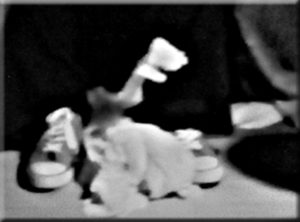
Picture: An Ectoplasmic hand can be seen rising from a pile
of ectoplasm at the feet of Felix Experimental Group medium.©
Séance Room Phenomena: Most séance room phenomena provide evidence for the existence of the psi field, the influence of intentionality on the psi field (psychokinesis) and the contact field concept. This primarily supports super-psi. However, the reunions between discarnate and still physical people provide a most profound form of evidence for survival. In a Class A example, the loved one (discarnate communicator) might materialize as an etheric form cloaked in ectoplasm. The materialized form might walk about, feel warm to the touch and look-feel just as he or she did in life. The materialized person might speak in his or her voice and say things unique to the person, sometimes conveying information unknown to anyone in the room. This form of demonstration is typically carried out in total darkness; however, there have been instances of the phenomena in reasonably good light.
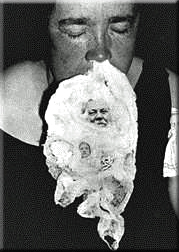 Picture: Conan Doyle’s Return, is an enlargement from the
Picture: Conan Doyle’s Return, is an enlargement from the
Dr. Thomas Glendenning Hamilton collection of physical medium, Mary Marshall as shown at: photographymuseum.com/doylefalg.html.©
Class A reunions are not common, but they are documented experiences. During a David Thompson séance, sitters were treated to the physical touch of Timothy, David Thompson’s playful, discarnate child who is said to be responsible for physical phenomena during séances. It was totally dark in the room, but he came to each sitter without hesitation or fumbling and held a finger with his tiny hands. While this would be considered a Class B example in ATransC terms, it was very evidential in that all sitters were holding hands to account for their whereabouts and Timothy’s hands were warm, soft and way too small to have been faked by an adult. Every sitter in the room had this experience. 23
Such phenomena are relatively common amongst the small community of people privileged to sit with a publicly demonstrating, evidential physical medium. Probably the most studied medium is the Felix Experimental Group medium.24 The phenomena produced by Mügge are well-documented, often in good red light. A number of highly qualified researchers have studied his work and there is little doubt as to the paranormality of the effects he produces. It is conceivable that an elaborate explanation for the phenomena depending solely on psi and residual energy might be concocted; however, at some level of complexity, such explanations are no longer tenable. The simplest explanation is that there are intelligences involved that are energetically outside of the séance room. See the Mediumship Essay
Precipitation Mediumship is a form of physical mediumship in which a substance is psychokinetically deposited into the physical. This is often in the form of paint on a canvas. It is thought to be facilitated by the medium but under the direction of a communicating personality.
Hoyt Robinette is often described as a precipitation medium because of the precipitated images he produces during some of his public demonstrations. In practice, pictures of people and/or animals appear on blank paper cards or pieces of cloth.13 The pictures often appear to be cut out of a magazine, and often, are identified as loved ones or people important to the sitter. Two important concepts associated with Robinette’s phenomena are intended order and apports.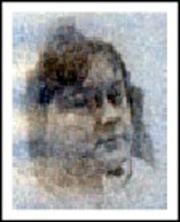
Picture: The precipitated image on cloth thought to be
Madam Blavatsky. Hoyt Robinette was the medium.
Precipitation Phenomena: In transcommunication, the common factor for both visual and audio ITC is a source of physical energy which is modulated with a chaotic process that can be influenced by the etheric communicator to produce an intended form. More or less random regions of order naturally emerge in chaotic processes. In ITC, that emergent order becomes the voice of EVP or the image of visual ITC, apparently under the influence of the communicating entity. A common characteristic of that intended order is the presence of both a primary feature and secondary features.
The images precipitated onto paper by Hoyt Robinette typically have a primary feature; however, at least in the example shown here which was received by me, a secondary feature was visible but faded within a day or so after formation. This secondary feature was much as is seen in video-loop ITC.
Images produced by Robinette often appear to have been taken out of existing media. Of course, this draws accusations of fraud, which might be difficult to counter were it not for the lack of means for executing the fraud, as witnesses will attest. Also, there are other forms of trans-etheric influence that appear to be taken out of the media. The most common example of this is the apport, in which physical objects are taken from one part of the world and deposited in another in an apparent process of dematerialization, transport in the etheric and materialization in the new location. Some examples of EVP and visual ITC also seem to have been taken from existing media, seemingly supporting the apport hypothesis.
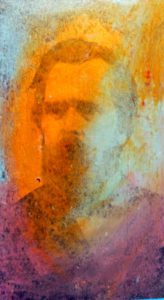 Picture: A precipitated image on a three-by-five-inch paper card.
Picture: A precipitated image on a three-by-five-inch paper card.
It is not known who the man is, but he bears a strong resemblance to the Butler family.
Precipitation phenomena represent a possible energy saving approach to transcommunication because it typically produces objects (images, thoughts, words, things) that have been previously embodied into the physical. In the Trans-survival Hypothesis, it is argued that the physical expression of intended information requires the avatar relationship. But the expression appears to have physical energy limitations that are seen to be moderated in many forms of influence by the use of stochastic amplification of existing physical forms of information. Apports may represent an alternative energy saving technique, but expression of the apported object would appear to depend on the influence of intended order.
Healing Intention provides an important tool for the study of intentionality. In the context of this article, the question of whether healing occurs is not as important as are the distant, objective changes thought to be caused by the influence of intention on the psi field. The verifiable existence of noncontact influence related to intention is necessary for both the Super-psi and Survival Hypotheses to be true. In the Trans-survival Hypothesis, it is proposed that noncontact healing intention involves:
- The physical healer’s expression of the intention to heal via his or her Creative Processes.
- Expressed through the healer’s etheric personality
- To the personality of the intended receiver
- To be expressed by the receiver’s perceptual processes to his or her physical body.
Implications
The fact of anomalous voices and images is well-established and mundane theory has not explained their existence. In some instances, visual ITC images have been decisively shown to represent a person who had long ago transitioned.5 Instrumental analysis of the voice in EVP, compared to recorded voice samples made of the person thought to be speaking, indicate the utterances are probably from that person. Some clearly understood phrases in EVP have been shown with instrumental analysis to be formed in novel ways, sometimes impossible for a human mouth.14, 15
In Spiritualism, mediumistic messages and healing intention are seen as originating from discarnate personalities. However, in most parapsychological research effects such as direct voice and healing intention are reported as psi functioning with no reference to a possible discarnate origin of the influences. The question is whether or not the practitioner is the cause (super-psi) or the agent (survival) is seldom considered. The result is an absence of consideration rather than a presence of evidence for or against survival.
Precipitation phenomena as seen in apports, images and possibly EVP, represents a set of physical and etheric phenomena that are far more complex than simple access of information as described in the Super-Psi Hypothesis. While it is not necessary that a survived or entangled etheric personality be involved in physical expression by way of precipitation, the effects are consistent with predictions of the Trans-survival Hypothesis.
Supporting Material in the Form of Indirect Evidence
The rationale for even considering the possibility of the Trans-survival Hypothesis is not based on the primary phenomena so much as it is on the implications of the often startling ways and circumstances under which individual examples occur. An excellent example is how a response to the practitioner’s question in EVP will sometimes be found in the sound file before the question is spoken. Yes, one can resort to quantum theory showing that information may exist independent of time and space, but if that were true, then it should be common for all sorts of events to occur out of sequence. In fact, the vast majority of experiences are appropriately sequential.
Answers preceding questions are predicted by the contention in the Trans-survival Hypothesis that transcommunication occurs via a mind-to-mind exchange of information between etheric personalities. The hypothesized communicator is an etheric personality with no physical body entanglement. Thus, communication between the communicating personality and the practitioner is seen as an exchange via the practitioner’s personality. It is known that a person first imagines what will be asked before actually expressing the question. That is a mental process providing information that would be available to a purely mental communicator prior to it being vocalized by the practitioner. 1234
This concept is modeled in the Perception essay. Please review the Life Field Complex diagram, as well.
The time interval between answer and question is consistent with the time usually required to mentally formulate a question. The idea that the communicators are in contact during the phrase formulation phase of the question seems to reinforce the idea that both are related mentally and not physically. Of course, the rest of the story is the intelligent response which indicates a sentient entity and not residual energy.
Examples of Phenomena Producing Indirect Evidence
Unique Information
To establish whether information a person senses is from the physical environment or from the psi field, it is necessary to somehow blind a person from physical information. This can be accomplished via various sensory deprivation techniques such as blindfolds, floatation chambers and acoustical suppression.
Then it is necessary to design a target to be sensed that is not known to the research subject supposed to be functioning as a psychic. Since witnesses are always alert for lucky guesses, cheating and unexpected prior knowledge, computers have been very successful for picking targets.
Testing for mediumship poses an even greater challenge. It must be possible to show that the target information could not have previously existed in the physical. Since there is no known way to shield from psi influence or hypothesized residual psi fields, it is necessary to design an event which can be initiated by the researcher that will produce an expected kind of response for which the exact response is unknown to anyone in the world.
EVP can be induced in that often questions can be asked by the practitioner or an interested observer and answered by the possibly discarnate personality. Sometimes EVP are clearly a response to an unexpected situation in the physical. An example of intelligent interaction not involving previously known information is the “Doja, no!” EVP recorded by Martha Copeland.
Martha Copeland’s daughter, Cathy, transitioned as a young woman and Martha assumed care for her dog named Doja. Martha had accidentally left Dojo in the house when she left to go shopping. It was her habit at the time to always leave her voice-activated digital recorder turned on, and so, it was also left on in the house with the dog. No one was in the house except for the animals. Dojo tore up a potted plant and made a great mess. You can hear an EVP from Cathy as she scolds the dog saying, “Doja, no!”
“Doja, no!”
Discarnate Cathy scolding her still physical dog is an example of an EVP in which no physical person was aware of the dog’s behavior. Even if Martha had been aware of the dog’s actions, she would not have had the technological wherewithal to manufacture Cathy’s voice saying the dog’s name in a scolding tone. It is possible to conceive of other alternative explanations such as psychic access to information. For instance, a person might have snuck into Martha’s home and saw the dog tearing up the plant. Martha could then have psychically sensed what the person witnessed, and thinking how Cathy would have scolded her dog, unconsciously created the EVP. All of this is possible within the Super-Psi Hypothesis.
A single instance of the “DoJa, no!” kind of EVP would be set aside as an anomaly amongst anomalies … an outlier to be discarded. However, it is a good example of a not so uncommon form of EVP. So, while it is tempting to contrive exotic alternative explanations, at some level of complexity, it becomes simpler to include this example amongst the collection of experiences indicating survival.
Implication: As the Implicit Cosmology has developed, the communicator is able to witness physical events via the senses of a physical person or animal. In the Doja example, Cathy would have witnessed the activity via her dog .
Mind-to-Mind Communication
As noted above, there is evidence in EVP of a mind-to-mind exchange between physical people and etheric communicators. The same has been noted for over a hundred years in the study of mental and physical mediumship.
Implication: Both the physical person and the communicator have a subtle-energy aspect which is independent of physical body and known physical principles.
Intended Order
A common factor in ITC is the transformation of broad-spectrum, chaotic energy into apparently intelligently intended features such as the voice in EVP8 and faces in visual ITC.7 Current research is showing that output of random event generators increase in order when in the presence of strongly expressed intention.25, 26 There is evidence in precipitation phenomena, such as spirit art, that the precipitation material undergoes a transformation from chaotic energy to intended order as raw material is brought and organized as the intended image.13 This research suggests that the basic element of the creative process is the emergence of intended order.
In this hypothesis, there is a proposed relationship between the influence of intention in the creative process and morphic fields. See Precipitation Mediumship in this essay
Implication: If there is a physical mechanism responsive to intention, and if that interaction can be seen to operate across many forms of trans-etheric influence, then it can be said that psi functioning is a common experience operating in more than just parapsychological phenomena (psychokinesis, distant healing, anomalous information access). If this influence can be demonstrated to affect formative fields, then the scope of psi functioning might be extended to include trans-etheric influences, collective consciousness and evolutionary influences.
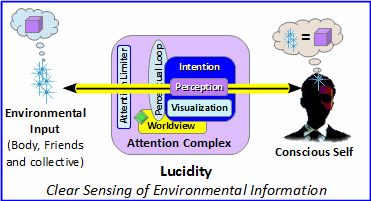
Lucidity
This is an old term referring to conscious awareness of unconscious processes. In the context of this hypothesis, it refers to conscious awareness of personality. The degree of one’s lucidity is how well a person is able to consciously sense the etheric personality, usually thought of as the seat of the unconscious mind. The objective of personal development of human potential is often to become as lucidly aware of the unconscious as possible.16
In the context of the Trans-survival Hypothesis, lucidity is used to describe the clarity between a person’s conscious self and unconscious personality. This is further discussed in the Personality essay. (The term is used in much the same way to describe how much a person is aware of activity during a dream. During a very lucid dream, the dreamer would be able to direct activity as if awake.)
A form of false lucidity is frequently encountered amongst new ITC practitioners. This is referred to here as hyperlucidity: the person claims the ability to produce astounding communication as if completely lucid. While there are practitioners who do produce impressive examples of transcommunication, this exaggerated form is characterized by a suite of behaviors which characterize a person who is sincere, but generally mistaken about this ability. Hyperlucidity is assumed to resolve itself as the practitioner becomes better informed.
Implication: The demonstrable difference between imagined (hyperlucidity) and real ability (lucidity) makes it clear that transcommunication is an ability that can be distinguished and developed. As such, it can be quantified.
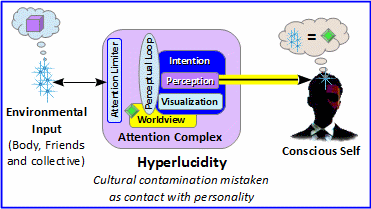
Animal Contact via EVP
EVP have been reported containing animal sounds, mostly dog barks or cat meows. A few EVP have been reported containing English-language phrases that appear to be initiated by dogs. Etheric communicators sometimes refer to family pets being with them on the other side. A relatively common form of apparition is a small animal, often thought to be a pet that has transitioned. The implication is that animals, certainly pets, survive transition in some form and interact with the physical much as discarnate people are thought to interact.
The Trans-survival Hypothesis supports the idea that a discarnate animal’s interaction with the physical would necessarily be via the witness’ (or an interested observer) etheric-to-physical entanglement. However, the Super-Psi Hypothesis might explain the impression of animal communication as either illusion or psi access to residual energy–a sort of energetic essence of animal.
As with all of these comparisons, the question that must be asked is how complex theoreticians are willing to make the Super-Psi Hypothesis to avoid considering survival. If the animal contact is unexpected, persistent and complex while retaining the animal’s personality, then is it reasonable to say that its presence is illusion created by the witness?
Implication: The most obvious implication is that humans are not unique in surviving. There is also reason to speculate that animals might express a psi influence on their environment. Certainly, there is nothing in the metaphysics that says animals can’t be avatars for personalities much as our human animals are our avatars.
Cultural Influence
An important aspect of ITC is the extent to which a person’s upbringing influences how trans-etheric influences are experienced. This is evident in mental mediumship in which the medium must always be mindful not to allow personal impressions to color the sensed message. In EVP, there is a clear relationship between religious upbringing and the nature of EVP recorded. For instance, a very religious person might record demon-like utterances while a more agnostic person might record neutral to friendly messages under the same circumstance. Trans-etheric influences are thought to begin as conceptual information. They must be embodied in some way via etheric-physical entanglement. It is the person’s worldview (or that of an interested observer) which is thought to color the message during translation from conceptual to objective form.
Implication: This effect is applicable to both hypotheses, but it especially makes sense if the avatar model is applied.
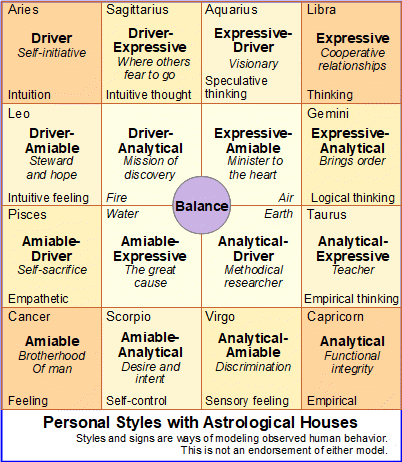
Personality Type
The Trans-survival Hypothesis proposes that a person’s intelligent core (etheric personality) is formed by a (creator) personality from which the person inherits an urge to gain specific understanding, and that a physical lifetime is an opportunity to satisfy that urge. As such, the physical aspect of reality is seen as a venue for learning.
At least for the physical, when a person is born, he or she begins with a worldview that is blank except for the inherited urge to gain specific understanding and a baseline of comprehension based on the progression of the person’s entangled etheric personality. This comprehension is based on prior understanding and can be thought of as a measure of the personality’s progression. Apparently by design, it is experienced as a nonspecific knowing (thus the term, comprehension rather than knowledge) to assure unhindered participation in this lifetime. A common term for this comprehension is spiritual maturity.
Throughout history, it has been noted that people are different and that people experience fundamental changes in their point of view as they gain understanding about the world they live in. This increased understanding is a measure of comprehension. The amount of understanding gained through experience is a function of the person’s comprehension. Thus, a person who was born with prior comprehension (understanding) will tend to gain more understanding from experience than people with relatively less comprehension.
For instance, in the ancient wisdom, the Major Arcana of the Tarot are designed to guide the student’s progression. The Hermetic relationship of comprehension with progression in the Tarot is closely related to the personality types described in astrology. In more modern times, it has been noted that people tend to fit into personality types.17 This knowledge has been an important tool for training salespeople. On close examination, the Tarot, astrology and modern personality types, like the concept of intelligence quotient,* are generally in agreement, suggesting the concept of increasing comprehension is a real experience for which the hypothesis should account.
Implication: The comprehension a person is born with and subsequent ability to learn and understand is not well explained today; however, it can be explained as comprehension gained by a survived personality prior to embodiment in the current lifetime.
* I understand that IQ and personality types are two different concepts. The commonality I am addressing here is the inherent difference people exhibit that is not necessarily related to physical ability, body type, education or culture.
Language
EVP are consistently recorded in a language the practitioner (or an interested observer) understands. For instance, with the practitioner speaking and understanding only English, and while recording for a Korean television crew, a Korean-language EVP was recorded. Otherwise, the practitioner only records English-language EVP.
The Trans-survival Hypothesis predicts that contents of a person’s worldview are used as a source of material to translate conceptual information from etheric communicators, including the person’s personality, as part of the process of embodying the information into the physical. As such, the resulting physical expression of the message would be based on what the person has learned.
The rest of this concept is that the only apparent constraints on who acts as the channel for the transformation from etheric to physical are that the person is in the physical and is aware of the communication. For instance, knowing that a practitioner in New York is conducting an EVP experiment to contact a loved one in his or her behalf, a person in Sacramento could provide the channel by which the response occurs in the practitioner’s recorder in New York.
Implication: The Super-Psi Hypothesis does not provide for translation of anomalously accessed information into a form that is understood by the practitioner or observers. The Trans-survival Hypothesis does provide for such information access–both by way of psi functioning such as remote viewing and information from survived personalities.
Discussion
Logical arguments in support of the Super-Psi Hypothesis usually center on three points:
- Psi functioning (Extra Sensory Perception or ESP and Psychokinesis or PK) have been conclusively shown to be real human abilities.
- Anomalous access to information is sufficiently accounted for by psi functioning without the need for a hypothetical survived personality.
- The concept of nonlocal information required for super-psi is seen to be supported by current understood of quantum theory. At the same time, the concept of a survived personality to explain these phenomena requires the introduction of radically new theories of science.
Point 1 is clearly true. The objective nature of psi phenomena is well established; however, the research does not preclude survival, it just seldom considers survival.
Appeal to Authority
There are many attempts in parapsychology to show that psi phenomena are explainable with existing physical theory. However, as noted below, these typically require poorly supported arguments which rely on appeal to authority rather than sound evidence.
The following items address anomalous access to information:
A. The retention of information in psi-space is supported with a number of concepts in quantum theory, but the applicability of those concepts is not clearly established.
Psi phenomena seem like some quantum phenomena but alternative theories may be more appropriate. For instance, research concerning the influence of intentionality on quantum-level phenomena in split-beam studies27 clearly show the influence of intentionality on photon entanglement, but our understanding of the influence of intentionality on chaotic systems could as well explain the observed effects.
The expression of intention can produce physical effects, but that does not imply that those physical effects explain the influence of intention.
B. It has not been shown that physical principles, such as conservation of momentum which apply to objective space, can account for retention of information in the psi field.
To my knowledge, no mechanisms for such retention of information have been proposed other than conservation of energy. Invoking conservation as a means of retaining information in the psi field assumes there is no attenuation in the psi field; a consideration I have not seen objectively substantiated.
First, it has not been shown that physical principles apply to the psi field (etheric). In fact, there is a sort of selective application of physical principles as needed to explain observed effects that looks a lot like “It seems like such-and-such physical principles apply” logic).
From my observations, physical principles are derivatives of the expression of intention; a conceptual-to-objective expression that is not reversible. Just as the influence of intention is an etheric equivalent to physical energy, so is attention an equivalent to conservation of energy. Without attention on information, it will undergo what appears to be a form of attenuation in which it eventually dissipates.
Second, there is a need for super-psi theorists to better explain organization of information in the etheric. As I understand First Sight Theory,21 as information is composed in a person’s mind, it is already a (probably gestalt-like) thoughtform that is made specific by a person’s perceptual process as it is moderated by worldview.
This is an important point. It is arguable that the information’s native form is a thoughtform which does not have objective components. Those components must be part of the conceptual-to-objective translation. As such, it is apparently native to the psi field in that conceptual form. See the Creative process and Perception Essays for further explanation of this concept.
Assuming the information does remain in the psi field via some as yet unidentified mechanism. The problem is that it is just conceptual information that requires the owner’s worldview to decrypt it into objective form which is appropriate to the original meaning of the information. When a mental medium with a different worldview accesses retained, conceptual information in the psi field, he or she will necessarily color the information based on his or her worldview. Without key points of reference required for correct decryption, such information will tend to be of very general or poor accuracy.
In Transcommunication between now discarnate personalities and still physical mediums, the information is presumed to come to the medium as that same gestalt-like thoughtform, but as an interactive exchange in which the sender is able to explain to the medium’s unconscious processes as a means of refining the accuracy of the information. In effect, many elements of the original worldview would be available.
This unconscious refinement of information exchange is indirectly supported by First Sight Theory. The conceptual nature of information exchange in the psi field is generally better addressed by the Trans-survival Hypothesis in which a still living personality is proposed as the source of information accessed by the mental medium.
Of course, this perspective also needs to be tested, but at least the hypothesis provides a context for some of the more astoundingly accurate mediumistic messages
C. The ability of a person to access the hypothetically retained information in psi-space is also poorly explained, other than indirectly by way of the objective evidence of such access.
Item B. is the first foundation concept for Super-psi. The second foundation concept for super-psi is that a person can psychically access the retained information, and sometimes describe it with great accuracy. Even stipulating that the psi field is nonlocal, there must be a mechanism for a mental medium to access survived information.
Here, a mechanism such as the Principle of Perceptual Agreement should be found in any such theory. In one expression, that principle can be modeled as a network router function, in that the perceptual process has access to all information, but what I refer to as the Attention Limiter filters out all but what is of interest to the person. (This functional area is shown in the Life Field Complex diagram above.)
Something like Perceptual Agreement should also provide a mechanism for contacting a specific survived personality. As such, in my view, many of the arguments in support of super-psi are arguably more applicable to survival.
D. To support the Super-psi Hypothesis, if retained information in the psi field is not used to explain mediumship, it is necessary to explain that such information is accessed via telepathy from someone still in the physical.
Of course, a living agent as a source of information is an attractive solution because, unlike Item A, B and C, it only requires that telepathic ability exists. It does not require the existence of a psi field or survived personality. If examples of information access can be found that do involve information no one in the physical was aware of, then it would seem to indicate support for survival.
Interestingly, some Super-psi advocates counter the “no one knew” argument with the idea that the psi field is nontemporal. For instance, say a medium correctly identifies a target selected by a computer. No one knows the target until the results are later checked. If all time is now in psi space the medium is presumably able to access the researcher’s future memory.
As it stands now, research seems to be supporting the idea that people react to events just before they occur. This is referred to as presentiment. The model that seems to work best is that the probability of the event is psychically sensed, and when the probability approaches certainty just before it occurs, the person is able to sense and unconsciously respond.29
Every event has some potential to occur. That potential is conceptual, and the psychically sensed potential of an event would be translated according to the person’s worldview. For instance, the growing possibility of a forest fire would easily pass the Attention Limiter of a person living in the forest. The person would unconsciously react, perhaps with a sense of urgency. This would be recognized as a form of presentiment and might produce a correct prediction.
Such correct foretelling of the future is evidence of psi function and the concept of potential. It is not necessarily proof that the psi field is nontemporal or that a person correctly guessing a target does so because he or she read the research’s future mind.
The Trans-survival Hypothesis proposes that psi functioning is a central human ability that is necessary for trans-etheric influences to occur. The difference between the two hypotheses is the path of information exchange. In super-psi, the information exchange is presumed to be between a person and the psi field in which minds are nodes and information is indefinitely stored.
Think of this as we are all one in a distributed network.
In the Trans-survival Hypothesis, anomalous access to information is presumed to be between etheric personalities. Information is indefinitely stored by the personality in a conceptual form as living memory and by the personality’s avatar in an objective form as worldview.
Think of this as we are all one in a star network.
Trans-etheric Influences
Anomalous access of information is modeled here as a trans-etheric influence. That is, the medium is modeled as a life field which consists of an etheric personality as the intelligent core entangled with a physical body in an avatar relationship. This is illustrated in the Life Field Complex Diagram (above). That diagram shows that the Attention Complex is shared with the human avatar. In effect, the Attention Complex is the unconscious component of a person’s mind.
The Body Mind functional area represents the intelligent core of the human body’s morphic field as proposed in the Hypotheses of Formative Causation.3 (See note below) In effect, formation and maintenance of the body is managed by the Body Mind while instinctual behavior is moderated by the entangled personality in the Attention Complex.
As modeled, all of the functional areas in the diagram are nonphysical (etheric). Also, two intelligent trans-etheric influences are represented in the diagram. In terms of transcommunication, morphic fields are etheric fields that directly influence physical processes to form and maintain a biological organism
Morphic Memory in the Body Mind functional area is defined by Sheldrake as Nature’s habit. That would be comparable to worldview for the avatar.
Morphic fields and thoughtforms are hypothetical and it is risky to support hypotheses with hypotheses, but they have been developed to account for observed phenomena. They provide a mechanism that integrates psi function and mediumship phenomena.
Note: Morphic Field
In formation of a living organism, the decision of how a cell will differentiate, such as skin, bone or membrane, is known as morphogenesis. Morphogenesis is managed by an as yet unknown (to mainstream science) mechanism.
Based on an explanation by Rupert Sheldrake in the Hypothesis of Causative Formation:
A morphic field is a field within and around a morphic unit which organizes its characteristic structure and pattern of activity. Morphic fields underlie the form and behavior of holons or morphic units at all levels of complexity. The term morphic field includes morphogenetic, behavioral, social, cultural, and mental fields. Morphic fields are shaped and stabilized by morphic resonance from previous similar morphic units, which were under the influence of fields of the same kind. They consequently contain a kind of cumulative memory and tend to become increasingly habitual.”3
In the worldview concept explained below, the “nature’s habit” functional area would be modeled as the worldview for that instance of morphic field.
References
- Butler, Tom and Lisa, “From Our Viewpoint–Proof of Survival,” Winter 2003 AA-EVP
NewsJournal, atransc.org/articles/butler-survival.htm. - Rousseau, David, “The Implications of Near-Death Experiences for Research into the
Survival of Consciousness,” Journal of Scientific Exploration, Vol. 26, No. 1, 2012 - Sheldrake, Rupert, Morphic Resonance and Morphic Fields: An Introduction,
sheldrake.org/research/morphic-resonance/ - Butler, Tom and Lisa, “Faces in Reflected Light,” ATransC, atransc.org/examples/faces_in_reflected_light.htm
- Butler, Tom and Lisa, “Faces in Light Reflected from Crystals,” ATransC, 2006
atransc.org/examples/light_from_crystals.htm - Downey, Margaret, “ITC experiments using Light Reflected from Water,” ATransC, 2007
atransc.org/techniques/techniques_downey_itc.htm - Butler, Tom, “Perception of Visual ITC Images,” ATransC, 2010
atransc.org/journal/visual_perception_study.htm - Butler, Tom, “EVP Online Listening Trials,” ATransC,
atransc.org/journal/online_listening_trials.htm - Bion, Stefan, EVPmaker, (software), tonbandstimmen.de/evpmaker/index_e.htm
- Downey, Margaret, “Randomly Processed Speech Synthesis EVP,” ATransC, 2008
atransc.org/examples/examples_voice_synth_1.htm - Butler, Tom, “EVPmaker with Allophones: Where are We Now?” ATransC, 2011
atransc.org/journal/evpmaker_study_response.htm - Kelly, Emily Williams, “Some Directions for Mediumship Research,” Journal of
Scientific Exploration, Vol. 24, No. 2, 2010, deanradin.com/evidence/Kelly2010mediumship.pdf - Butler, Tom and Lisa, “Sitting with Hoyt Robinette, ATransC,” Fall 2010 ATransC
Scientific Exploration, NewsJournal, atransc.org/circle/hoyt_robinette.htm - Gullà, Daniele, “Computer–Based Analysis of Supposed Paranormal Voice: The
Question of Anomalies Detected and Speaker Identification,” Interdisciplinary
Laboratory for Biopsychocybernetics Research (biopsicocibernetica.org), 2004
Bologna, Italy,
atransc.org/journal/gulla-voice_analysis.htm - Butler, Lisa, “Voice in Death Same as that in Life,” ATransC, 2005,
atransc.org/journal/voice_analysis-sonia.htm - Lucid Dreaming FAQ, lucidity.com/LucidDreamingFAQ2.html
- Butler, Tom, “Understanding Balance by Understanding Personality Types, Etheric
Studies, 2010, ethericstudies.org/writing/personality_types.htm - Leary, Mark, “A Research Study into the Interpretation of EVP,” ATransC,
atransc.org/journal/radio-sweep_study2.htm - Butler, Tom, “Critiquing ITC Articles written by Imants Barušs,” Etheric Studies,
ethericstudies.org/failure-to-replicate-itc/ - MacRae, Alexander, “Report of an Anomalous Speech Products Experiment Inside a
Double Screened Room,” 2003, as printed in the Journal of the Society for
Psychical Research, spr.ac.uk/. - Carpenter, James, First Sight: ESP and Parapsychology in Everyday Life, Rowman & Littlefield Publishers, 2012, ISBN 978-1-4422-1392-0 (ebook), firstsightbook.com
- Cunningham, Paul F. , “The Content-Source Problem in Modern Mediumship
Research,” Journal of Parapsychology, Vol. 76 No. 2, 2012, Page 295,
parapsych.org - Butler, Tom and Lisa, “Viewpoint,” ATransC NewsJournal, Summer 2012,
atransc.org/circle/thompson_seance_viewpoint.htm - Butler, Tom and Lisa, “A Visit to the Felix Experimental Group,” ATransC NewsJournal,
Fall 2010, atransc.org/circle/felix_circle.htm - Radin, Dean; Utts, Jessica, Experiments Investigating the Influence of Intention on Random and Pseudorandom Events, Journal of Scientific Exploration, Vol. 3, No.1, pp. 65-79. 1989, scientificexploration.org/journal/jse_03_1_radin.pdf
- Mason, Lynne; Patterson, Robert; Radin, Dean, “Exploratory Study: The Random Number Generator and Group Meditation,” Journal of Scientific Exploration, Vol. 21, No. 2, pp. 295–317, 2007, deanradin.com/papers/RNG%20Mason.pdf
- Dean Radin, Leena Michel, Karla Galdamez, Paul Wendland, Robert Rickenbach, “Consciousness and the double-slit interference pattern: Six experiments,” 2012, deanradin.com/papers/Physics%20Essays%20Radin%20final.pdf
![]()


Hello following reading this article it seems to float in the right direction of my own thought process and would like the opportunity to discuss in greater detail with you.
Many Thanks
Thanks for taking the time to comment Kirsten. It is important that the model is vetted by as many people as possible, so I am always open for discussion. One good place to discuss these concepts is in the ATransC Idea Exchange: http://atransc.org/forum/ Otherwise, What are your thoughts?
Thank you for all of the time and effort you have expended to help us find answers. In the article, Trans Survival Hypothesis, paragraph titled Etheric, there is a sentence that is a bit confusing. I believe the word entered, * employees (noun) * should actually read employs (verb). It took me several readings to get the intended meaning. I am offering this correction in a spirit of gratitude for all of the hard work you have done. The paragraph is copied below for your consideration.
Etheric: Etheric is an old term referring to heaven. Following the lead of parapsychology, psi (specifically psi field) is used here as the foundation stuff which emanates from a source and from which all of reality is formed. In this model, it is influenced by intention to produce ideoplastic structures via the creative process, which is the model used here *** to describe the process life forms employees to express themselves. *** The psi field should be thought of as a characteristic of reality from which aspects (sub or local realities) of it are derived by differentiation.
Jim, thanks for taking the time to let me know about those errors. I think I have them corrected now. I nearly flunked out of college because of poor grades in English and grammar. Because of the complexity of my writing and how much I write, I finally gave up on using a proofreader in favor of simply getting the material out. Not a good excuse, but my alternative to not writing.
Always looking for this kind of input. Thanks!